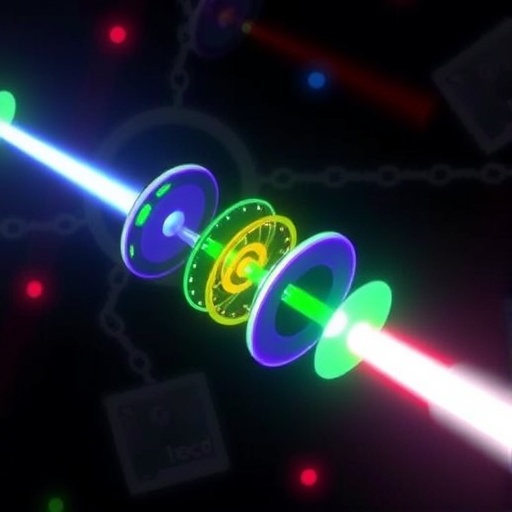In a groundbreaking advancement that could redefine the future of electronic materials and photonics, researchers at Helmholtz-Zentrum Berlin (HZB) and their international collaborators have demonstrated a novel mechanism to dynamically manipulate electron interactions in nickel oxide (NiO), an archetypal charge-transfer insulator. Utilizing ultrashort ultraviolet (UV) light pulses on the order of femtoseconds, the team achieved an unprecedented temporal control over electron correlations—those inherently strong repulsive forces that typically freeze electron mobility in many metal oxides. This work opens a fresh frontier for engineering the electrical and optical properties of materials in real-time, promising transformative impacts on technologies ranging from photovoltaics to ultrafast optoelectronics.
Metal oxides like nickel oxide have long been studied for their critical roles in both natural and synthetic processes, finding applications in catalysis, energy conversion, and electronics. Despite their abundance and potential utility, their widespread technological deployment has faced a persistent obstacle: the strong Coulomb repulsion between electrons localized at metal sites impedes charge transport. This electron-electron interaction, often described as correlation effects, fundamentally limits the conductive and dynamic behavior of these materials, rendering them insulating or semiconducting under normal conditions.
In their latest experimental campaign, researchers exploited the interaction between ultrafast UV light pulses and the NiO crystal lattice to transiently alter these electron-electron interactions. By delivering pulses lasting mere tens of femtoseconds, a timescale that challenges conventional measurement, they observed a momentary weakening of electron repulsions. This modulation decreased the energy barrier for electron hopping between adjacent metal atoms, effectively inducing a metallic-like conduction state in an otherwise insulating material. Such optical control of electronic correlations is unique in its speed and reversibility, outpacing traditional methods relying on temperature, chemical doping, or pressure.
The team’s experimental methodology was notably sophisticated, employing multicolored UV probe pulses to simultaneously measure absorption changes and reflectivity dynamics. These measurements were conducted at the LACUS facility in Lausanne, Switzerland, a cutting-edge laboratory dedicated to ultrafast spectroscopy. Leveraging the ultrafast temporal resolution available, the researchers could map electron interactions with exquisite precision, revealing how light intensity linearly scaled the suppression of electron correlations. This linear relationship is particularly significant for tuning material responses predictably under varying illumination conditions.
Nickel oxide’s electronic structure provided an ideal platform for this investigation due to its charge-transfer insulating state, a condition shaped by complex hybridization between nickel and oxygen orbitals. Beyond its fundamental interest, NiO bears close resemblance to high-temperature superconducting cuprates, making insights gleaned from this work potentially translatable to unraveling mechanisms behind superconductivity and other emergent quantum states in correlated oxides.
Remarkably, the induced metallic state was not fleeting but persisted for hundreds of picoseconds before the system relaxed back to its equilibrium insulating state. This persistence affords a practical timeframe for integrating such optically controlled phases into device applications. Even more compelling is the consistency of the relaxation dynamics, which remained invariant across different excitation densities, highlighting an intrinsic property of the system’s response to photodoping.
This research heralds a paradigm shift not only in controlling electron correlations with light but also in envisioning future devices that exploit dynamic switching between insulating and metallic states at ultrafast speeds. The ability to modulate electron repulsions using light pulses could lead to breakthroughs in light-harvesting technologies, where charge mobility is crucial, or enable the development of photonic switches and memories with vastly superior response times compared to electronic counterparts.
Collaborations extended beyond HZB, encompassing leading institutions such as the Max Planck Institute for the Structure and the Dynamics of Matter, Helmholtz Center for Materials and Energy, Elettra Synchrotron Trieste, Paul Scherrer Institute, University of Basel, University of California Davis, and the Simons Foundation Flatiron Institute. This broad partnership underscores the multidisciplinary and international effort required to harness and understand ultrafast phenomena in complex materials.
From a fundamental perspective, these findings address enduring challenges in condensed matter physics related to the control of strongly correlated electrons. The insights gained propel the scientific community closer to coherent manipulation of quantum states on demand, a critical step toward realizing quantum materials with tailor-made properties. The knowledge that electron correlations can be dynamically tuned with light expands our understanding of nonequilibrium phases of matter, an area ripe with unexplored territory.
Experimentally, the meticulous combination of ultrafast pump-probe spectroscopy with theoretical simulations allowed for a comprehensive characterization of the transient states. Simulations validated the experimental data, providing microscopic understanding of the interplay between photo-excitation and electron correlation strength. Such integrative research methodologies are increasingly vital as the complexity of experimental data grows with the need for concurrent spatial and temporal resolutions.
Looking ahead, adapting this concept to other charge-transfer insulators and correlated electron systems could unlock a suite of materials exhibiting similarly tunable properties. In particular, the potential to combine ultrafast optical control with other external stimuli—like strain or electrochemical gating—could provide multi-dimensional control over material properties, facilitating multifunctional device architectures.
Beyond the immediate scientific community, the implications for industry are profound. Photonic devices leveraging such effects could operate at unprecedented switching speeds, minimizing energy consumption and maximizing efficiency. Solar cells and photocatalysts might also benefit from enhanced charge mobility achieved through light-induced correlation control, potentially revolutionizing renewable energy technologies.
This discovery places dynamic control of electron correlations at the forefront of materials science and condensed matter physics, highlighting the power of light as not just a probe but a tool for engineering matter at its most fundamental level. Continued exploration of ultrafast spectroscopic techniques promises further breakthroughs in understanding and controlling the quantum landscape of materials, paving the way for technology once relegated to science fiction.
Subject of Research: Not applicable
Article Title: Dynamic control of electron correlations in photodoped charge-transfer insulators
News Publication Date: 5-Sep-2025
Web References: http://dx.doi.org/10.1126/sciadv.adx5676
Image Credits: Thomas Rossi / HZB
Keywords
Materials science, Physics




